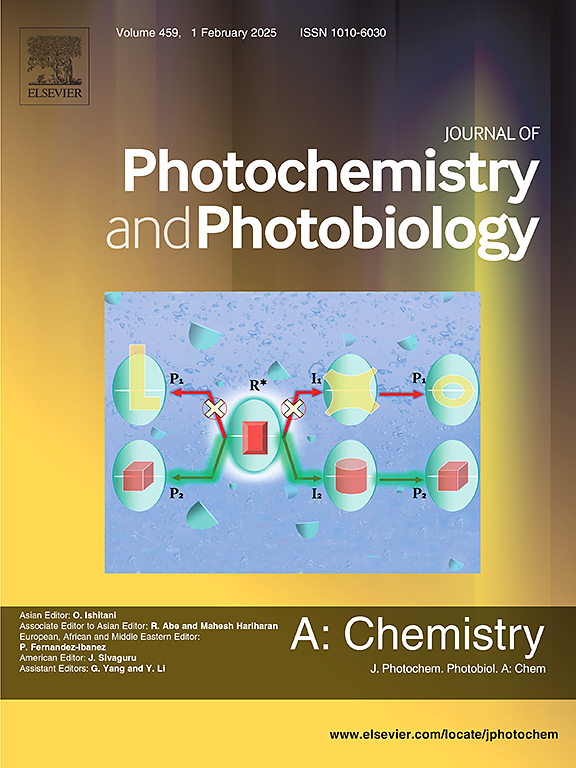SBA-15负载铁纳米颗粒降解有机污染物的光催化活性研究
IF 4.7
3区 化学
Q2 CHEMISTRY, PHYSICAL
Journal of Photochemistry and Photobiology A-chemistry
Pub Date : 2025-06-25
DOI:10.1016/j.jphotochem.2025.116597
引用次数: 0
摘要
随着罗丹明B (RB)、对硝基酚(PNP)、环丙沙星(CPX)、布洛芬(IBP)和扑热息痛(PCT)等有机污染物在水源中的普遍存在,需要开发有效和可持续的降解技术。本文采用湿初始体积浸渍法,将Santa Barbara amorphus -15 (SBA-15)负载的二氧化硅用铁(Fe)纳米颗粒浸渍,然后进行干燥(Fe/SBA-15 D)或煅烧(Fe/SBA-15 C)。在紫外光照射下,通过光解、多相光催化和光fenton工艺考察了这些催化剂对有机污染物的降解性能。x射线衍射表征证实了Fe浸渍后SBA-15的介孔结构得以保留。氧化铁纳米颗粒的存在被确定,特别是在Fe/SBA-15 c中。氮的吸附-解吸分析显示,比表面积减少,表明Fe物种部分填充了SBA-15孔隙。紫外-可见漫反射光谱结果表明,Fe的加入降低了带隙能量,增强了光催化活性。x射线光电子能谱分析结果表明,Fe/ sba - 15d中Fe2+的含量较高,而Fe/ sba - 15c中Fe3+的含量较高。Fe/ sba - 15d与过氧化氢(H2O2)对RB、PNP、IBP和PCT的降解效率较高,Fe/ sba - 15c对CPX的降解效果较好。对RB、PNP、CPX、IBP和PCT的最大降解率分别为100%、99.45%、91.54%、86.08%和86.11%。这些结果归因于高浓度Fe2+与H2O2的协同作用以及硫酸盐(SO42−)离子的存在促进了羟基自由基(•OH)的产生,这些离子作为活性位点和电子空穴陷阱。本研究证实了•OH自由基是有效降解目标有机污染物的主要活性物质。本文章由计算机程序翻译,如有差异,请以英文原文为准。

Photo-catalytic activity of iron nanoparticles supported on SBA-15 for degradation of organic pollutants
The increasing prevalence of organic pollutants such as rhodamine B (RB), p-nitrophenol (PNP), ciprofloxacin (CPX), ibuprofen (IBP) and paracetamol (PCT) in water sources necessitates the development of effective and sustainable degradation technologies. Herein, Santa Barbara Amorphous-15 (SBA-15) supported silica was impregnated with iron (Fe) nanoparticles using the wet-incipient volume impregnation method, followed either by drying (Fe/SBA-15 D) or calcination (Fe/SBA-15 C). The organic pollutant–degrading performance of these catalysts was evaluated via photolysis and heterogeneous photo-catalysis and photo-Fenton process under ultra-violet (UV) irradiation. Characterisation via X-ray diffraction confirmed the preservation of the mesoporous structure of SBA-15 after Fe impregnation. The presence of iron oxide nanoparticles was identified, particularly in Fe/SBA-15 C. Nitrogen adsorption–desorption analyses revealed a decrease in the specific surface area, indicating the partial filling of SBA-15 pores with Fe species. UV–visible diffuse reflectance spectroscopy showed a reduction in the bandgap energy after the incorporation of Fe, which enhanced photo-catalytic activity. X-ray photo-electron spectroscopy results revealed that Fe/SBA-15 D contained a high proportion of Fe2+, whereas Fe/SBA-15 C exhibited excess Fe3+. Fe/SBA-15 D with hydrogen peroxide (H2O2) degraded RB, PNP, IBP and PCT with high efficiency, while Fe/SBA-15 C was substantially effective for CPX degradation. The maximum degradation% of RB, PNP, CPX, IBP and PCT were 100 %, 99.45 %, 91.54 %, 86.08 % and 86.11 %, respectively. These results are attributed to the generation of hydroxyl radicals (•OH) facilitated by the synergistic effect of a highly concentrated Fe2+ with H2O2 and the presence of sulfate (SO42−) ions, which serve as active sites and electron–hole traps. This study confirms that •OH radicals are the primary reactive species responsible for the effective degradation of target organic pollutants.
求助全文
通过发布文献求助,成功后即可免费获取论文全文。
去求助
来源期刊
CiteScore
7.90
自引率
7.00%
发文量
580
审稿时长
48 days
期刊介绍:
JPPA publishes the results of fundamental studies on all aspects of chemical phenomena induced by interactions between light and molecules/matter of all kinds.
All systems capable of being described at the molecular or integrated multimolecular level are appropriate for the journal. This includes all molecular chemical species as well as biomolecular, supramolecular, polymer and other macromolecular systems, as well as solid state photochemistry. In addition, the journal publishes studies of semiconductor and other photoactive organic and inorganic materials, photocatalysis (organic, inorganic, supramolecular and superconductor).
The scope includes condensed and gas phase photochemistry, as well as synchrotron radiation chemistry. A broad range of processes and techniques in photochemistry are covered such as light induced energy, electron and proton transfer; nonlinear photochemical behavior; mechanistic investigation of photochemical reactions and identification of the products of photochemical reactions; quantum yield determinations and measurements of rate constants for primary and secondary photochemical processes; steady-state and time-resolved emission, ultrafast spectroscopic methods, single molecule spectroscopy, time resolved X-ray diffraction, luminescence microscopy, and scattering spectroscopy applied to photochemistry. Papers in emerging and applied areas such as luminescent sensors, electroluminescence, solar energy conversion, atmospheric photochemistry, environmental remediation, and related photocatalytic chemistry are also welcome.

 求助内容:
求助内容: 应助结果提醒方式:
应助结果提醒方式:


